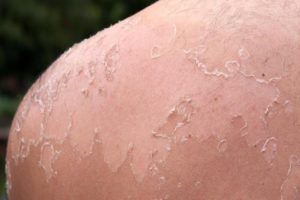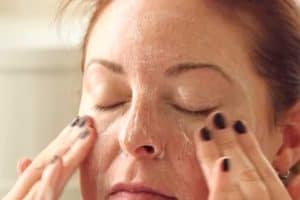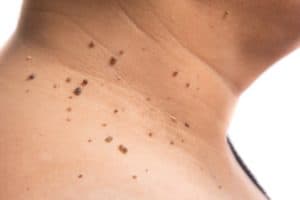Hydrochloric acid (HCl) is a dangerous liquid that can cause chemical burns in the right concentrations. It can even cause death if ingested. If this liquid gets in contact with human skin or animal skin, it can cause severe damage to tissues. In other words, it is a hazardous chemical.
Hydrochloric acid is a highly corrosive substance that can damage the skin, eyes, and mucous membranes. Even short-term inhalation may lead to irritation of your eyes, ears, and nose. Unfortunately, hydrochloric acid is commonly spilled on the skin of people who work with it.
What happens exactly when you get hydrochloric acid on skin? You don’t want hydrochloric acid to get into contact with your skin. Hydrochloric acid on the skin is the most common cause of chemical burns.
The symptoms of hydrochloric acid contact are the grayish or whitish discoloration of the skin and exposed mucosa.
It is a dangerous chemical that should be used carefully. In concentrated form, it releases harmful acidic mists. Exposure to these mists can cause irreversible damage to the skin, eyes, and internal organs.
Read on to learn more about hydrochloric acid on skin, including the potential effects and treatments.
Also, for an excellent soothing product for burns, take a look at our top pick, the ELEMIS Skin Nourishing Milk Bath:
Click here to see it on Amazon.
What Is Hydrochloric Acid?
Hydrochloric acid is a water-based or aqueous solution of hydrogen chloride gas. It’s the major component of gastric acid, produced by four basic methods: the chlorination of organic chemicals or the combination of hydrogen and chlorine.
Hydrochloric Acid is an important chemical that is widely used in many industries. The most common end uses of the acid are for steel pickling, food manufacturing, oil well acidizing, ore processing, and producing calcium chloride.
This substance is highly corrosive and should only be handled by qualified personnel and with the right safety precautions. Because it is such a commonly-used chemical, reports of it being spilled on the skin are all too common.
Hydrochloric Acid on Skin
Your skin will suffer chemical burns if it comes into contact with hydrochloric acid. So what should you do if you get hydrochloric acid on your skin?
If you accidentally spill it on your skin, you need to flush the contaminated portion of your skin with water immediately. You should keep on flushing it with water for the next 15 minutes, or else there will be an onset of chemical burns that will damage your skin tissues.
Most chemical burns are caused by accidental contact with hydrochloric acid. If you have already suffered chemical burns, you need to seek medical help at once to avert further damage to your skin.
What Happens When Hydrochloric Acid Contacts the Skin?
A chemical burn will occur when a living or organic tissue comes into contact with a corrosive substance. Hydrochloric acid is a corrosive substance, so are oxidizers, bases, and cytotoxic agents, such as arsine, lewisite, and mustard gas.
When HCl hits your skin, it will diffuse into your skin tissues and damage the cellular structures under your skin. The danger here is that there will be no apparent damage to the skin surface at the moment it happens.
You won’t even feel anything at the start. But this substance will react with the acidic molecules or the fatty acids of your skin.
The damage to your skin is due to dehydration. The acid will remove water from the cell wall molecules and destroy them all. Damaged cells die before any pain signals are sent to your brain.
First, you will feel some tickling on your skin with extreme pain afterward. By the time you feel such pain, the damage has already started.
In other words, you may be unaware that your skin is already burning. There’s no pain or feeling at all. The reason is that the acid effectively stops your nervous system.
If the contact is extensive, a person can burn all his skin, and his organs will stop functioning, leading to his death. If not, the damage will be for life.
What Are Chemical Burns?
Skin exposure to HCl is an example of a chemical burn. Chemical burns are primarily due to accidental skin contact with acids and bases.
Since hydrochloric acid is one of the most common chemicals used in many consumer products and school laboratory experiments, chemical burns can happen to anyone. It can occur at home, in school, and workplaces.
Chemical burns can cause skin damage. Severe cases of chemical burns can even cause death. That is why such cases require emergency medical intervention to prevent further damage or fatal results. But the majority of chemical burns are not life-threatening.
Most people who experience chemical burns can fully recover without any severe damage to their skin and overall health.
If you need to store hydrochloric acid in your home or at work, make sure that it is stored carefully and safely. The container must be appropriately labeled so that healthcare providers can accurately trace the cause of accidental exposure.
Also, you need to take extra care if you are required to work with hydrochloric acid to avoid accidents.
Hydrochloric Acid on Skin Treatment – Emergency First Aid
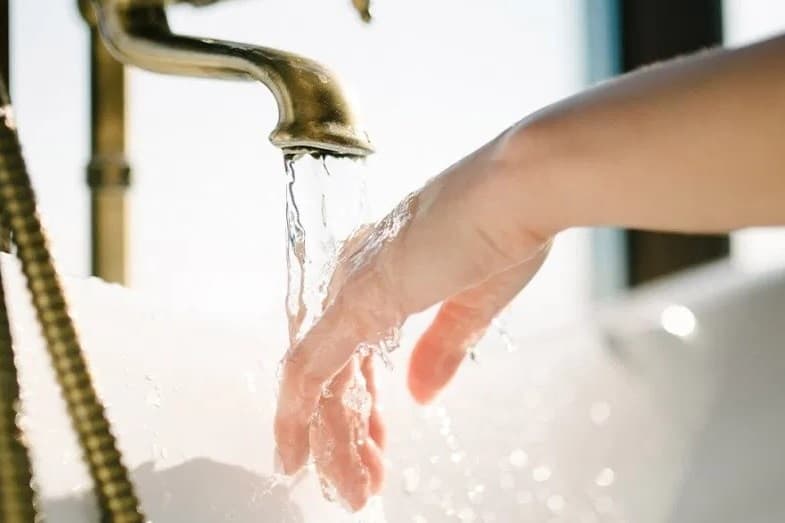
So what to do if you get hydrochloric acid on your skin? If you’ve been exposed to HCl or someone you know has just come into accidental contact with hydrochloric acid, here are the emergency interventions that you need to do:
- Get rid of the bottle or container of hydrochloric acid.
- Flush the HCl off the skin with cool running water for 10 to 15 minutes.
- Remove any jewelry or clothing contaminated with HCl.
- Don’t rub or wipe off hydrochloric acid from the affected skin area.
- If HCl gets into the eyes, flush them with running water for 15 minutes.
- If the affected skin becomes red, swollen, painful, and visibly burned, seek medical attention at once.
- If the chemical burn is less severe, cover the burned skin with a clean bandage.
- If complications occur, seek medical attention right away.
Other Tips for Hydrochloric Acid Skin Burns
Chemical burns due to hydrochloric acid are serious. Even if you don’t feel any symptoms of a chemical burn, you should still seek medical help. You also need to know how to treat this type of chemical injury to minimize skin damage.
Below are the things you need to do in case hydrochloric acid gets in contact with your skin:
1. Be Aware of the Effects of Hydrochloric Acid
Determine the extent of acid burn on the skin. Acid burns can be classified by degrees.
- First-degree burns affect the first layer of the skin. These burns require just 3 to 5 days to heal. The majority of these burns are not painful since there is no nerve damage.
- Second-degree burns affect the skin and a small layer of the muscle. These burns are the most painful since many nerves are affected.
- Third-degree burns result in extensive damage. Such injuries require special treatments and procedures, including skin grafting. In this case, nerve endings are damaged and burned, causing a bit of pain to no pain at all.
2. Seek Medical Help
If the following happens to a person who just had a chemical burn, seek immediate medical help:
- If the victim is suffering from unbearable pain
- If the contaminated skin area is large
- If the victim manifests signs of shock, such as shallow breathing, acute skin blanching, and blurred consciousness
- If the hydrochloric acid has contaminated the eyes, genital organs, esophagus, and other internal organs
Treatments for Hydrochloric Acid on Skin
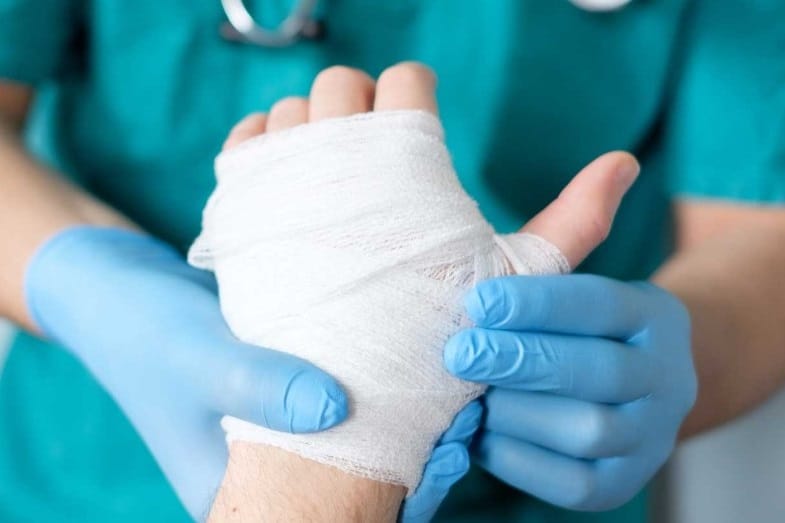
Healthcare providers will initially prescribe some preliminary medications to lessen the pain, other unpleasant sensations, and prevent shock. They may prescribe the following medications:
- Ibuprofen – In tablet form, from 300 to 600 mg, up to 4 times a day
- Paracetamol – In tablet form, from 0.5 to 1.5 g up to 4 times a day
After treating the pain, the attending physician will then apply an ointment designed to treat acid burns on the affected skin. The ointment can help accelerate the regeneration of damaged tissues.
It will also facilitate the proper healing of the skin. The following topical medications are known for the treatment of skin burns:
- Panthenol Gel – This ointment will help restore damaged tissues and mucous membranes.
- Desitin – This drug contains zinc oxide, which can soften and dry wounds. It also works great as a protective film on the surface of damaged skin areas.
- Sudocrem – Like Desitin, this ointment also contains zinc oxide. It can help disinfect the wound, remove wetness, and prevent inflammation.
The epithelialization stage of wound healing will follow where the restoration or regeneration of the epidermis takes place.
At this stage, the victim needs to take vitamin supplements to accelerate wound healing and also increase the body’s metabolism. The doctor will most likely prescribe the following vitamins:
- Supradyn – A multivitamin supplement that can be taken by both adults and children.
- Vitrum – A vitamin product that contains all the necessary nutrients the body requires for optimal functioning.
Vitamin supplements must also contain vitamin A, ascorbic acid, and omega-3 fatty acids.
- Vitamin A – This vitamin will help prevent infection in damaged tissues.
- Ascorbic Acid – This vitamin helps in maintaining healthy cellular structures.
- Omega-3 Fatty Acids – These fatty acids will help prevent inflammation and jumpstart the recovery process.
Healing will also be accelerated if vitamin supplements contain glucosamine, collagen, and calcium.
During the rehabilitation stage, patients with chemical (acid) burns will be given physiotherapeutic treatment. Such therapy will prevent complications, improve blood circulation, and eliminate necrotic tissues. Here are the typical procedures that will be performed on the patient:
- Ultrasound and phonophoresis
- Electrophoresis and diadynamic therapy
- Aeroionotherapy (with analgesics)
- Ultraviolet radiation
- Magnetotherapy (transcranial method)
- Sessions of therapeutic sleep (transcranial electroanalgesia)
The treatment for acid or chemical burns is usually complex and utilizes all possible modalities to ensure fast healing and alleviate the suffering of the victim.
Alternative treatments could also be performed on the victim. However, it’s a controversial topic. This route should only be taken with active doctor consultation. Some of the alternative methods that will alleviate the suffering of chemical burn victims include:
- The application of fresh burdock leaf to the affected skin
- Using milled leaves of cabbage
- Compresses from baking soda solutions
- The application of gruel made from freshly grated potatoes
- Using aloe vera or compresses soaked in aloe vera juice
Home Treatment of Scars from Acid Burns
Most likely, a scar will form on the damaged skin after the wound heals. Seek help from a dermatologist if the scar is extensive. However, you can also do some home treatments at this stage.
- If there is no extensive scarring of the skin, you can apply freshly crushed papaya on the scar or use papaya soap.
- Massage the affected area with lime juice.
- Apply lotions containing vitamins E and K.
- Apply mild pressure on the scar.
How to Handle Hydrochloric Acid
To prevent contact with hydrochloric acid on the skin, you should always perform safety precautions when handling this substance.
1. Storage
- Always label the bottles containing HCl.
- You should always store HCl in a glass bottle in a well-ventilated area.
- HCl bottles should be stored in a safe place far from the reach of children and unauthorized persons.
- Only authorized personnel should be allowed to store HCl and take out HCl containers in and out of the storage room.
2. Personal Protective Gear
- Don’t forget to wear protective gear on your hands, eyes, nose, and ears whenever you open HCl containers.
- Always wear hand gloves when handling HCl.
- Always wear goggles, face masks, and ear covers when working with HCl.
3. Transporting HCl
- Always transport HCL in tightly closed glass bottles.
- The bottles should be safely stacked on vehicles to avoid spills, in cases of bumps on the road.
- For warm climates, the bottles should be placed in coolers during transport to prevent gas buildup inside the containers.
4. Contingency Spills
- To take care of contingency spills, you should prepare emergency equipment. An emergency kit must include absorbent materials, such as soda ash, lime, or sodium bicarbonate.
- Put chemical wastes into adequately labeled containers.
- Wash residues using a copious amount of water.
- Don’t let the runoff contaminate water supplies, creeks, or rivers.
Conclusion – Hydrochloric Acid on Skin: Effects and Treatments
To recap, hydrochloric acid on the skin is one of the most common causes of chemical burns. The symptoms of hydrochloric acid contact are grayish or whitish discoloration of the skin and exposed mucosa.
Hydrochloric acid is a dangerous liquid that you should handle carefully. In concentrated form, it releases harmful acidic mists. If these mists get in contact with your skin, irreversible damage to your skin, eyes, and internal organs could result.
Mild chemical burns may be treated using home remedies. However, people with extensive chemical burns caused by hydrochloric acid often require immediate medical intervention to prevent further damage.
Related reading:
Battery Acid on Skin: Symptoms, Treatments, and Pictures
Jalapeno Burning Skin? How Long Does It Last?





![Bleeding Pore on Nose [11 Possible Causes and Treatments] bleeding pore on nose](https://skincaregeeks.com/wp-content/uploads/2021/04/bleeding-pore-on-nose-150x150.jpg)
![Bruise Itches [Causes and Treatments for an Itchy Bruise] bruise itches](https://skincaregeeks.com/wp-content/uploads/2021/04/bruise-itches-150x150.jpg)
![Neutral Skin Tone Defined [and Best Colors for Neutral Skin] neutral skin tone](https://skincaregeeks.com/wp-content/uploads/2021/05/neutral-skin-tone-150x150.png)

